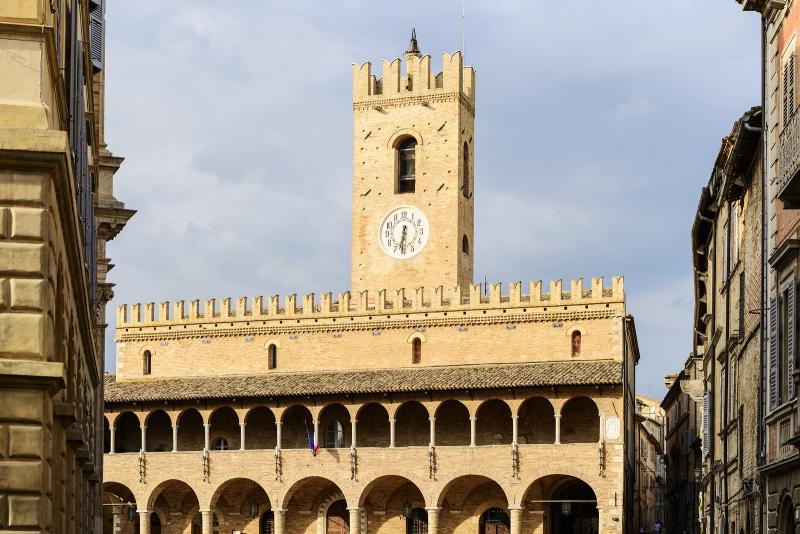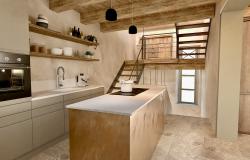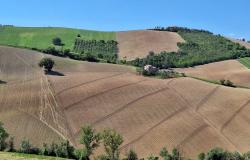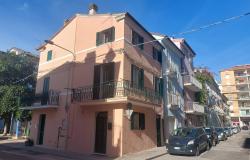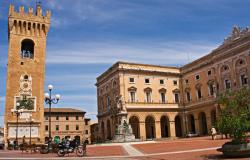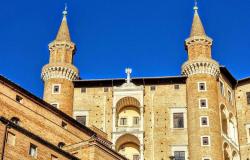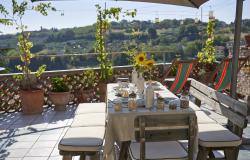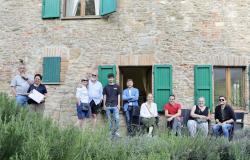Le Marche’s pastoral landscape is bookended by two of its most dramatic features: the rugged Sibylline mountain chain bordering the region to the west and the vast eastern coastline, stretching almost 200 kilometers and lapped by the Adriatic Sea. Most visitors to the region concentrate on one or the other, either exploring the Sibylline Mountain National Park on foot, bike, or horseback; or whiling away the days at the water’s edge, lined with beach clubs that range from the fashionable to the family-friendly.
There is, however, a middle ground between these two extremes. Vast stretches of rolling hills extend from the inland mountains to the coast, covered by orderly fields, pastures, and vineyards and dotted with quiet villages that beckon with simple small-town charm. Whether you’re looking for the perfect piazza for an aperitivo and dinner al fresco after the rigours of a mountain hike, or need a break from the coastal chaos, these secret spots are a delight.
alt="" src="/sites/default/files/feature-story/gallery/20180905_201530.jpg" style="width: 624px; height: 351px;" />
Offida: Old Lace, New Wine
With a main square straight out of central casting, a unique (and stunning) local craft, and a wine-tasting room in the town’s newly renovated 16th-century palazzo with underground cellars dating from the Middle Ages, the sleepy town of Offida has a little something for everyone.
Set on a hilltop just north of the Marche/Abruzzo border overlooking some of the region’s most fertile wine country, this walled Medieval village centers around the main Piazza del Popolo. Home to two churches (the Chiesa dell’Addolorata and the Chiesa della Collegiata) and the 12th-century town hall, this square is one of the most postcard-perfect in the region. The piazza is also home to the Teatro Serpente Aureo (or Theater of the Golden Snake), a pocket-sized gem with a meticulously restored 19th-century interior that is the perfect backdrop for Offida’s surprisingly active theater and opera season, though it is beloved by the locals primarily for its raucous Carnevale celebrations each year.

Other town highlights include the Romanesque Church of Santa Maria della Rocca, decorated with 14th-century frescoes and a small carving of a lamb on the steps down to the crypt, said to bring good luck to all those who give it a pat on their way down; and the Municipal Museum, home to a painting gallery, archaeological collection, folk section, and, most importantly, the Museum of Merletto a Tombolo.
Merletto a Tombolo (Bobbin Lace)
Offida has been known for its prestigious lace production since the 15th century, and still today shop windows from the grocery to the dry cleaner hold impromptu displays of lace produced by the local merlettaie (lace makers). Produced by pinning paper patterns to a round cushion and then weaving and knotting dozens of strands of silk, cotton, or even golden threads weighted by wooden bobbins into intricate designs over weeks or months, this lace is considered among the best in Italy. Pop into the local lace museum to see historic and contemporary pieces, or, better yet, stop to watch one of the many lace-makers at work in doorways and workshops across town. You’ll find that the complicated movement of their fingers doesn’t slow as they chit-chat and gossip amongst themselves, and they are thrilled to share the pride in their craft with passers-by.

Wine Tasting
Offida sits in the center of one of Le Marche’s most productive wine countries, home to two DOC labels (Rosso Piceno and Falerio) and three DOCGs (Offida Pecorino, Offida Passerina, and Offida Rosso). The town hosts the Enoteca Regionale delle Marche (Regional Wine Information Center) inside the historic Monastery of St. Francis, but for a unforgettable tasting of the local wines, stop in Palazzo Mercolini Tinelli in the main Piazza del Popolo, where the flagship Ciù Ciù winery has recently restored the interiors to use as pretty tasting rooms, furnished with antiques and overlooking the square. Be sure to tour the underground cellars, a warren of halls and tunnels that burrow under the square above and are now used as barrel rooms. Ciù Ciù produces a full range of whites, reds, rosés, and sparkling wines that combine local varietals with international crowd-pleasers, all grown in the vineyards surrounding Offida.

Where to Eat: Osteria Cantina Offida (Piazza del Popolo; Tel: +39 0736.880104). Just across the square from Palazzo Mercolini Tinelli, this informal eatery features local specialties. Be sure to get the sample cheese and charcuterie platter, and pair it with one of the excellent local wines from their extensive wine list.
Where to Stay: Idea18 Offida doesn’t offer much in the way of accommodation, but just a short drive away over the border into Abruzzo, this chic design B&B combines impeccable Milanese style with warm country hospitality. With just five rooms, guests feel like they are staying in a private home...albeit one with a gourmet restaurant and swanky pool on the ground floor.
Like this article? Don't miss "Beaches, Hiking and Culture: Discover Le Marche’s Conero Riviera"
Grottammare: Hilltown Charm with a Seaside View
If you’re taking a beach holiday along the coast but the Adriatic’s endless stretch of rather soulless hotels and modern beach clubs has left you cold, a trip to the timeless hamlet of Grottammare Alta just a few minutes inland on an outcropping directly above the marina may be just what the doctor ordered.
Grottammare Alta or Vecchio Incasato (not to be confused with the marina of Grottammare, the modern town of the same name along the water’s edge) is recognized as a Borgo Più Bello d’Italia (Most Beautiful Village in Italy) and its tiny cluster of stone houses, pedestrian lanes, and miniature squares seems a world away from the bustle of the beaches just below. Take the steep, winding road up the slope of Monte Castello and park just outside of town to explore this pretty hamlet on foot. Though you can poke your nose into the Churches of San Agostino and Santa Lucia (the latter built in the 16th century on the site of the house where the future Pope Sixtus V was born), tour the Teatro dell’Arancio, and admire the Church of San Giovanni Battista (home to the Museo Sistino’s collection of sacred art), the real charm of Grottammare is simply in wandering its quiet streets and sipping a glass of wine in the sweet Piazzetta Peretti.
Bird’s-Eye Views
You’ll want to capture the endless views over the Adriatic Sea and coastline to the north and south from Grottammare, so be sure to bring your camera. You can head to the 10th-century fortress ruins above the Medieval village center and the lane in front of the 16th-century facade of Santa Lucia for worthwhile views, but don’t miss the panorama from the newly restored brick loggia beneath the Teatro dell’Arancio lining the main Piazzetta Peretti.

Surprising Art
Just because Grottammare is a small hamlet doesn’t mean it can’t be home to big art. The 16th-century Torrione della Battaglia holds a collection of works by modern sculptor Pericle Fazzini, known primarily for his Resurrezione located in the Vatican’s Sala Nervi. In addition, the local Museo Il Tarpato is dedicated to Giacomo Pomili (known as Il Tarpato), a beloved 20th-century folk artist and painter.
Where to Eat: Osteria dell’Arancio (Piazza Peretti; Tel: +39 0735 632214). If you dream of whiling away a few hours at a table under a striped awning in the most picture-perfect piazza on the Adriatic, this is the place. Local ingredients prepared with a contemporary twist, stellar wines, and lots of atmosphere make this the ideal lunch or dinner spot.
Where to Stay: Valentino Resort To visit Grottammare Alta, the closest place to stay is the marina of Grottammare, the seaside resort area along the coast below the hamlet. This family-friendly apartment hotel has the convenience of kitchenettes and adjoining rooms, but doesn’t skimp on the extras like an in-house spa, outdoor pool, and dedicated beach club.
